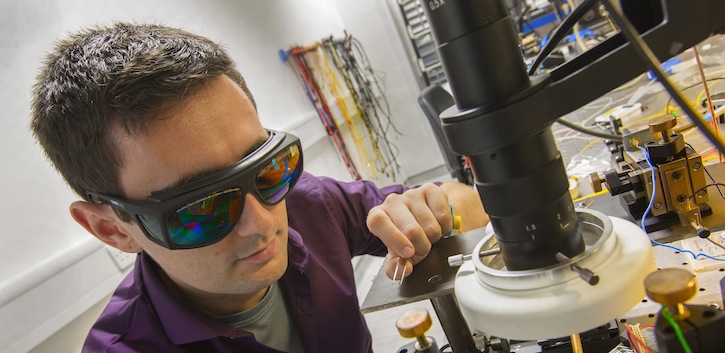2014 Press Releases
Powering Christmas through Lasers/LEDs

Dr Padraic Morrissey of the Irish Photonic Integration Centre (IPIC) at Tyndall National Institute tells us why we should look at Christmas in a different light (originally appeared in the Irish Independent's 'Science of Christmas'):
Often, the best inventions and technologies have uses outside of what they were originally developed for. In optical communication this is particularly true, where the recent advances in Laser and Light Emitting Diodes (LED) systems have not only led to faster internet speeds, but are now being used to spread some festive cheer in the form of Christmas decorations!
How you ask?
A great deal of effort was spent by scientists and engineers on designing low cost and energy efficient light sources for sending information that could be used for thousands of hours without burning out or losing brightness. This technology is now feeding into the design of far more efficient optical Christmas trees, light sculptures, string lights and countless other decorations; where traditional incandescent bulbs are being replaced by LEDs.
LEDs were initially developed in the early 1900s, when a researcher first saw a faint light coming from a special crystal diode (an object which only allows flow of electricity in one direction). This unique light emission, which was known as electroluminescence, began the development of LED lights.
So this year, if you are in the market for new Christmas lights, our advice is to go LED. LED lights do not have a filament like incandescent bulbs, so they won’t burn out or get too hot. They are also pretty difficult to break, last a considerably long time and are almost 90% more efficient than the old bulbs. What’s not to love?
Although the initial price might put you off, if you consider the hugely improved efficiency, then your investment will pay off with savings on your electricity bill.
Plus, with Christmas tree fires contributing to an average of 18.3 million dollars in property damage each year in the USA, it makes safety sense too. In many of these cases, hot Christmas lights are to blame, a problem that is non-existent with LED lights.
For many of us, the warm glow of Christmas is very much linked with a dazzling array of multicolored lights, be it in our homes or in our cities. By choosing LED lights, you can make yours a greener, and slightly cheaper Christmas for years to come.
(Reproduced courtesy of The Irish Independent/Katherine Donnelly - originally appeared in the supplement 'Science of Christmas' published 11 December 2014)
Check out the Science of Christmas supp. in today's @Independent_ie featuring IPIC's own Padraic Morrissey http://t.co/XVC5DBzkqZ
— IPIC (@IPICIreland)
December 11, 2014
